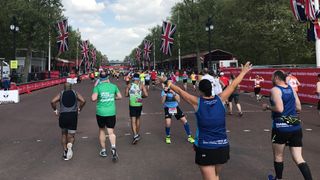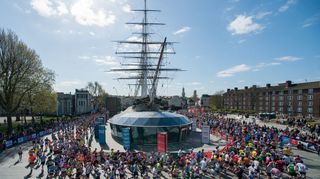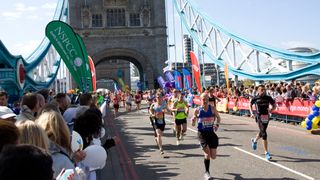The Runner’s Guide To The London Marathon Route
Your blow-by-blow guide to the course of the London Marathon

The most important information about the London Marathon route is that by and large it’s flat. It’s a great route for PB seekers and you can tailor your marathon training around a flat race without the fear of a climb or two knocking you off your rhythm on the day.
It’s important to note that your London Marathon start point will determine your route, because runners are split up for the first few miles to avoid too much congestion in the early stages of the race.
Another thing London Marathon runners need to know is that during the race you’ll notice blue lines on the road. These mark the fastest route and sticking to them throughout will mean you run the exact marathon distance. However, owing to the huge number of runners you’ll encounter, this is impossible for all but the fastest elites, and all the unavoidable weaving and running wide at corners means you’ll probably run slightly more than 26.2 miles/42.2km, so don’t get angry at your running watch if this is the case.
One other thing to note is that the London Marathon provides both mile and kilometer markers along the route, so you can race using whichever measurement you prefer and use the markers to help judge your pacing. More useful details about the route can be found in our London Marathon route FAQs section, below.
And if you’re a spectator looking for advice on where to stand, these are the best places to watch the London Marathon.
London Marathon Route Map
London Marathon Route Mile By Mile
The Start
Depending on the color marked on your race number, you’ll begin from one of three start zones. These keep runners separate for the first few kilometers, before everyone merges together.
Miles 1-2
Runners head east from the start in Greenwich for a couple of miles, where the aim is just to avoid going too quick and/or getting tripped up in the swarm. Stay calm and don’t worry if you feel like you’re losing a tiny bit of time in the mêlée—better to do that than expend energy weaving past people.
Miles 3-4
The Green and Blue runners join the Red and Yellow route around 2.8 miles in, and although they’re kept separate for a while eventually everyone merges, so if you’ve just escaped a crowd from your start wave, expect to be part of another. The good news here is that this section is downhill, considerably so in places. Don’t be alarmed to find you’re running 10 seconds per mile faster than your planned pace here—you’ll make up some time from the crowded first few miles by easing down the hills.
Miles 5-7
The crowds of supporters really press in on the runners at some points of this section, which makes it easy to high-five people but also means the route can be a little narrow. Just after 10K you’ll reach the Cutty Sark, one of most popular points on the whole course for supporters. Revel in the crowd and the knowledge that you’ve completed the first quarter of the marathon.

Miles 8-12
There’s not a lot going on here, to be honest. The crowds are still great, but the route is pretty bland as you wind around Rotherhithe and on towards Tower Bridge. Settle into your pace after the excitement of the Cutty Sark—you should be feeling strong during this section.
Miles 13-14

Get ready for a whirlwind of emotions. First there’s the joyous experience of going over Tower Bridge. Then there’s the slight downer of turning right after the bridge at a point where you can probably see the fastest runners coming back the other way on their way to the finish. And then you hit halfway and all the joy comes back. With runners and supporters on both sides of the road, this is one of the loudest and most inspiring sections of the race. Headphones out.
Miles 14-21
Headphones back in—this tends to be the section where it starts to hurt. Although the Isle of Dogs and Canary Wharf have more supporters than they used to, it’s still the least exciting part of the course and as you pass the 20-mile mark you’ll probably be reaching the limits of your training runs. The route winds around Canary Wharf a bit and you’ll have to watch out for runners starting to slow down as they hit the wall. Not you, though—you’re killing it.
Miles 22-23
As you pass the hordes of supporters around Shadwell, enjoy the boost of knowing you’re in the home straight now. Whip off the headphones and gain as much energy as you can from the crowd.
Miles 24-25
Just three miles (5km) to go. That’s a parkrun—you can do that. And this is the most picturesque part of the race, with landmarks aplenty to look out for as you run along Embankment. Before that, however, you run through the Blackfriars Underpass. This is a rare moment where the crowd disappears, which is a bit of a relief if truth be told, and allows you to gather yourself before the last mile or so. The other thing to know about the Underpass is that some runners will use the relative privacy of the tunnel to relieve themselves, or have a little cry, or throw up. Or all three.
The Finish
Once you turn off the Embankment on to Birdcage Walk you’re unbelievably close to the end. Buckingham Palace is ahead of you, but you have to endure a long slog of a straight to get there so we recommend keeping your head down to avoid the despair when you feel that it doesn’t seem to be getting any closer. Then you suddenly reach it, turn the corner on to the Mall, and the finish line is right there. Congratulations, you’re a London Marathon finisher!
London Marathon Route FAQs
Where does the London Marathon start?
The London Marathon starts in Greenwich Park in Blackheath.
What is the best Tube station for the London Marathon start?
Technically, there are no Tube stations near the London Marathon start, but there are rail and DLR stations which are part of the Transport for London public transport network. The best station for the start line depends on your start zone, because the starting areas are spread out across Greenwich Park to avoid congestion in the first few miles of the race. There are four start areas—Red, Blue, Green and Yellow—and you can find out which one is your starting area by looking at your registration email or race bib (the color of your number and its background indicates your starting zone).
Once you know your start zone, you’ll know which station to travel to. If you’re in either the Blue or Yellow start, Blackheath is the best station. Greenwich is the best for the Red start, and Maze Hill is the best stop for the Green start.
Where does the London Marathon finish?
The London Marathon finishes on The Mall, a stretch that runs from Buckingham Palace to Whitehall, where a huge crowd always gathers to roar the runners home.
Is the London Marathon a flat course?
As with many big-city marathons, the London Marathon route is designed to be as close to pancake-flat as possible. In fact, the most notable changes in elevation on the course actually run downhill. (More info on those below.) I’ve run the race four times with different watches and the recorded total elevation gain has been between 119m and 138m, which really is not a lot over the course of a marathon. There’s also no single long climb to worry about—just a few small bumps along the way.
Is the London Marathon route always the same?
The London Marathon route has been the same since the first event back in 1981, with the notable exception of 2020 during the COVID-19 pandemic, when the live race was restricted to elite participants and involved running laps of St James’s Park.
Where can I get a GPX file of the route?
You can easily find GPX files for the London Marathon online, and organizers have helpfully posted the route on Strava.
However, the race has three different starts which that route doesn’t account for, and only after around three miles do the routes converge. The Good Run Guide offers the route from the Red Start, but your best bet might be searching Strava for a runner’s activity from a previous event and downloading that. Here’s my 2021 run from the Blue Start.
Is there water on the London Marathon course?
Yes. There are water stations every two miles on the course with a line of people handing out plastic bottles of Buxton water. Bottles are easier to drink from when running than paper cups, but that’s a lot of potential plastic waste. To mitigate that, each bottle is made from recycled plastic and organisers aim to recycle every bottle. In order to do that, the bottle must be empty, so runners are asked to drink, drain any remaining liquid and then drop the bottle in dedicated bags that will line the route. Don’t drop them on the floor as they become a trip hazard. The London Marathon also sells a bottle belt, designed to accommodate the bottles handed out on the course. However, if you have not trained with one do not strap one on to use in the race—the risk of chafing is too great.
Lucozade Sport, one of the best sports drinks, is available in cups at miles 9, 15, 21 and 23.
Get the Coach Newsletter
Sign up for workout ideas, training advice, reviews of the latest gear and more.

Nick Harris-Fry is a journalist who has been covering health and fitness since 2015. Nick is an avid runner, covering 70-110km a week, which gives him ample opportunity to test a wide range of running shoes and running gear. He is also the chief tester for fitness trackers and running watches, treadmills and exercise bikes, and workout headphones.
